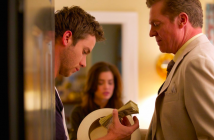Editor’s Notes: The following capsule reviews are part of our coverage of the Sundance Film Festival. For more information visit their website here and follow Sundance on Twitter at @sundancefest.
The Stanford Prison Experiment (2015)
Dir. Kyle Patrick Alvarez
To call director Kyle Patrick Alvarez (C.O.G.) and one-time South Park screenwriter Tim Talbot’s The Stanford Prison Experiment, a chilling, disturbing, discomfiting dramatic recreation of the title experiment, a horror film might sound, at least initially, facile or simply wrong, but the increasingly humiliating, punitive encounters between “guards” and “prisoners” (student volunteers in a mock prison), each one delivered with formal, non-sensationalistic restraint by Alvarez, strongly suggests otherwise. In the title experiment, Stanford University professor, Philip Zimbardo (Billy Crudup), sought to explore and examine how rules and roles rather than character traits or personality shaped, guided, and ultimately determines actual behavior in an institutional setting, specifically a prison environment. Zimbardo and his team arbitrarily divided student volunteers into two distinct categories, prisoners and guards. The prisoners were forced to wear tunics (dresses), hair stockings, and identified strictly through pre-assigned numbers. The guards were given uniforms, sunglasses, and batons. They were told to strictly enforce the rules, but couldn’t use physical force. Isolated from the outside world for the better part of a week, the guards abused their power, often taking pleasure in handing out punishment for minor infractions. The prisoners initially responded by engaging in relatively minor acts of rebellion, but repeated punishments wore them down. By the end of the shortened experiment (less than a week, rather than a planned two weeks), roles and rules had subsumed individuality and personalities. It was and continues to be a chilling conclusion, one skillfully, expertly handled by Alvarez and his collaborators, including an impressive group of young actors drawn from television and film.
Hellions (2015)
Dir. Bruce McDonald
Maybe more than any genre, horror suffers from an overabundance of mediocre and sub-par work, often the result of limited budgets and even more limited imaginations. Hellions, TV and film director Bruce MacDonald’s first foray into horror since the underseen gem PontyPool seven years ago, repeatedly proves that particular point. A derivative mash-up of Rosemary’s Baby, early Cronenbergian body-horror, and H.P. Lovecraft (among others), Hellions staggers through rote characterizations, rote plot turns, and rote visuals, each one individually and concurrently undermined by hyper-caffeinated sound design and an over-emphatic musical core. From the first scene of Hellions’ heroine, Dora Vogel (Chloe Rose), an all too typical “final girl,” in mid-banter with her too-cool-for-school boyfriend, Jace (Luke Bilyk) in a cemetery on Halloween, it’s abundantly clear that the audience can expect a mediocre or sub-par effort. A seemingly random doctor’s visit reveals that Dora (17 going on 24) is pregnant. Her physician, Doctor Henry (Rossif Sutherland), talks her down, but Dora’s interest in Halloween wanes considerably for understandable reasons. Left alone in her house when her mother and brother go out trick-or-treating, Dora’s wait for a never-to-arrive Jace turns malevolent when several trick-or-treaters attack the house, chanting “Blood for baby” over and over. As their attacks grow increasingly violent, Dora finds a temporary ally in the local sheriff, Corman (an always welcome Robert Patrick), but true to form, finds herself alone and forced to fight for her (insert yawn) survival. While Hellions falls far short of horror genre worthiness, MacDonald deserves credit, albeit of the minor kind, for occasional flashes of visual inventiveness, bathing Dora’s house and the surrounding land in an eerie violet glow. The pint-sized demonic creatures of the title are also imaginatively realized, but like so much else in Hellions, they’re underused and/or misused.
The Witch (2015)
Dir. Robert Eggers
Far more than a historical footnote or the subject of two or three high-school lectures, the Salem witch trials of the 17th century have long held a peculiar fascination for historians, cultural critics, and artists, most notably Arthur Miller’s McCarthy-era allegory of authoritarianism and repression, The Crucible. We can add Robert Eggers’ remarkably assured feature-length debut, The Witch, to the works of art (and entertainment) that explore, examine, and dissect that particular time period in a provocative, thought-provoking, and intelligent manner. That The Witch is also a horror film, albeit an art-horror film with everything that implies (e.g., formal, rigorous visual style, thematic complexity, and interpretive ambiguity), shouldn’t be considered a weakness or the primary point of emphasis in a critique, but as a strength or asset in its favor. With its focus on an isolated, exiled Puritan family who face first, major economic hardships and second, the disappearance and presumed death of their youngest child, a newborn, The Witch immerses moviegoers in a world that’s simultaneously familiar and strange. Eggers carefully delineates the personalities and relationships among and between the family members, but ultimately centers the film on Thomasin (Anya Taylor-Joy), a teenage girl whose burgeoning sexuality exposes minor fissures that over time turn into major faultlines that threaten the family’s survival. Eggers’ eye for carefully composed visual images, camera angles, and (minimal) camerawork suggests the influences not of genre filmmakers, but more high-minded, self-consciously serious filmmakers like Carl Theodor Dreyer (Ordet, Vampyr), Stanley Kubrick (The Shining, Barry Lyndon), and Andrei Tarkovsky (Stalker, The Sacrifice).
Results (2015)
Dir. Andrew Bujalski
Mumblecore pioneer Andrew Bujalski (Computer Chess, Mutual Appreciation, Funny Ha Ha) tries his hand at a conventional romantic comedy with his fourth feature-length film, Results, but comes perilously close to outright failure. It starts semi-promisingly enough as a modest, surface-deep satire of the fitness industry and idle, indolent members of the upper class, but gradually devolves into a dreary, dull focus on the underdeveloped central conflict between Guy Pearce’s Trevor, the super-fit, middle-aged owner of a fitness instructor, Power-4-Life, and his best fitness instructor, Kat (Cobie Smulders). They had a thing once, but they no longer have that particular thing (or any other thing for that matter except a professional thing). Singularly concentrated on expanding his fitness center (new location, possible franchise), Trevor doesn’t have time for romantic entanglements. Kat seems to think otherwise, but continues to work at the fitness center, taking on a newly wealthy, out-of-shape, pudgy client, Danny (Kevin Corrigan), less as a challenge than as another way to prove her value to Trevor. An unconvincing romantic triangle forms between Danny, Kat, and Trevor. The complications, misunderstandings, and miscommunications typical of the romantic comedy genre keep the narrative wheels turning until the inevitable denouement. By then, however, Bujalski has succeeded – either intentionally or non-intentionally – to make Kat almost wholly unlikeable with Trevor a close second. Characters in romantic comedies, of course, don’t have to be likeable, just relatable or root-worthy. Results isn’t subversive enough genre wise to give Bujalski, an obviously talented filmmaker, the benefit of the doubt.




